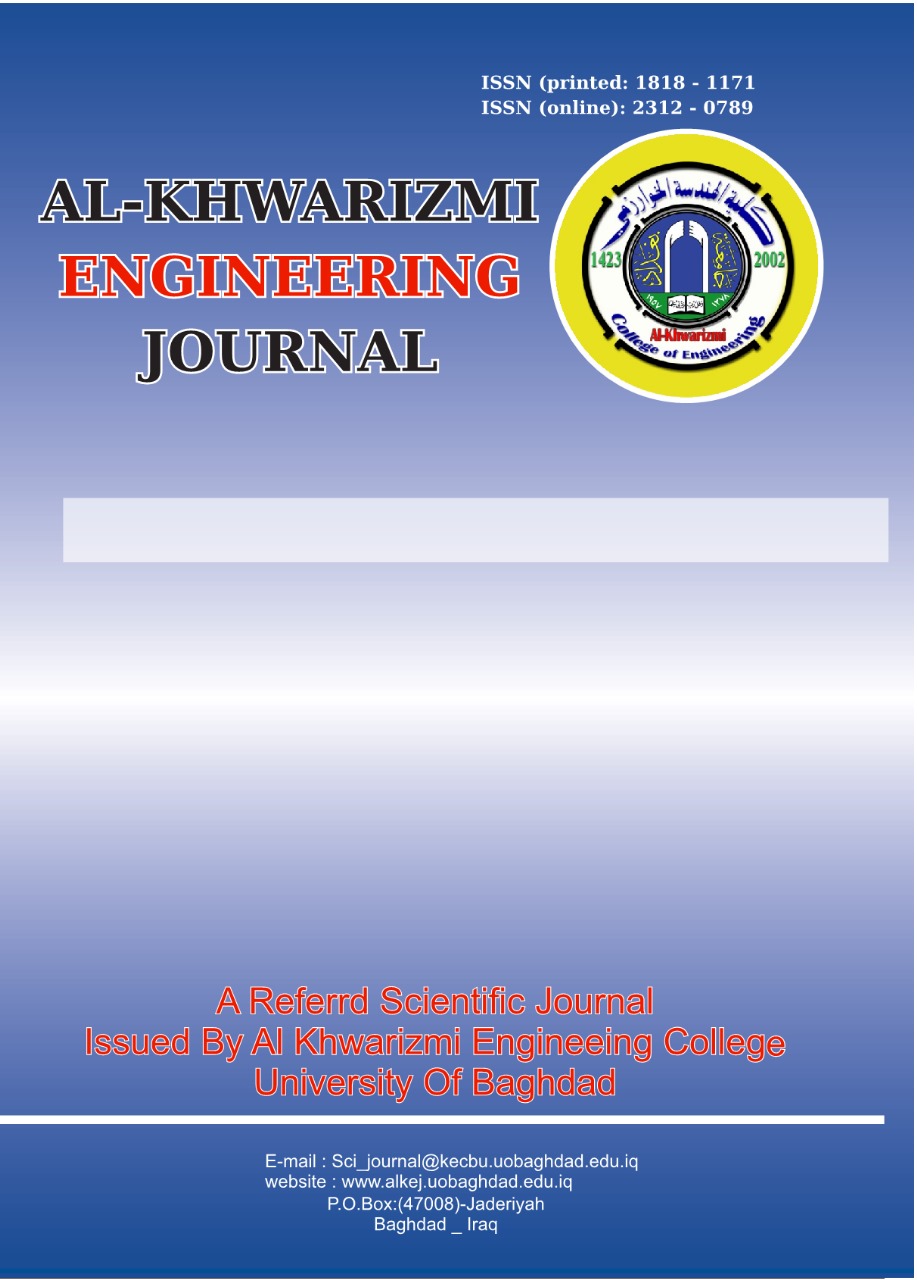تأثير عدد العناصر العاكسة وموقع نظام STAR-passive-ORIS القابل لإعادة التكوين في أنظمة MIMO FSO
DOI:
https://doi.org/10.22153/kej.2025.02.004الكلمات المفتاحية:
Free space optics (FSO); Intelligent reflecting surface (IRS); Nonorthogonal multiple access (NOMA); Radio frequency (RF); and simultaneous transmitting and reflecting reconfigurable intelligent surface (STAR-RIS).الملخص
تهدف هذه الدراسة إلى تحسين أداء نظام STAR-passive-OIRS القابل لإعادة التكوين في أنظمة الاتصالات الضوئية في الفضاء الحر القائمة على MIMO. تركز الدراسة على تحليل تأثير عاملين رئيسيين: عدد العناصر العاكسة وموقع السطح الذكي. أظهرت تقنية STAR-RIS إمكانات كبيرة في تحسين كفاءة الطيف ونسبة الإشارة إلى الضوضاء والتداخل (SINR) وزيادة مكسب القناة، من خلال توفير تغطية بزاوية 360 درجة وتقليل التداخل في البيئات ذات قيود خط البصر (LOS). تكشف النتائج أن زيادة عدد العناصر العاكسة يعزز قوة الإشارة ويحسن نسبة الإشارة إلى الضوضاء والتداخل بينما يحقق وضع السطح الذكي أقرب إلى المصدر أو المستقبل الأداء الأمثل. تسلط الدراسة الضوء على قدرة تقنية STAR-RIS على التغلب على قيود أنظمة FSO التقليدية وتحسين أداء الشبكة في بيئات الاتصالات اللاسلكية الحديثة.
التنزيلات
المراجع
[1] M. A. Atiyah, L. F. Abdulameer, and G. Narkhedel, “PDF Comparison based on Various FSO Channel Models under Different Atmospheric Turbulence,” Al-Khwarizmi Engineering Journal, vol. 19, no. 4, pp. 78–89, 2023. Available: https://doi.org/10.22153/kej.2023.09.004
[2] A. A. Abdullah, “Study the effect of Iraqi weather parameter in FSO communication using different wavelength (650, 532) nm,” Iraqi Journal of Physics, vol. 16, no. 36, pp. 104–112, 2018. Available: https://doi.org/10.30723/ijp.v16i36.35
[3] M. J. Al-Dujaili and M. A. Al-dulaimi, “Fifth-generation telecommunications technologies: Features, architecture, challenges and solutions,” Wirel Pers Commun, vol. 128, no. 1, pp. 447–469, 2023. Available: https://doi.org/10.1007/s11277-022-09962-x
[4] Q. Wu, S. Zhang, B. Zheng, C. You, and R. Zhang, “Intelligent reflecting surface-aided wireless communications: A tutorial,” IEEE transactions on communications, vol. 69, no. 5, pp. 3313–3351, 2021. Available: https://doi.org/10.1109/TCOMM.2021.3051897
[5] T. N. Do, G. Kaddoum, T. L. Nguyen, D. B. Da Costa, and Z. J. Haas, “Multi-RIS-aided wireless systems: Statistical characterization and performance analysis,” IEEE Transactions on Communications, vol. 69, no. 12, pp. 8641–8658, 2021. Available: https://doi.org/10.1109/TCOMM.2021.3117599
[6] L. F. Abdulameer and H. Fadhil, “Performance Analysis of FSO under Turbulent Channel Using OSTBC,” Al-Nahrain Journal for Engineering Sciences (NJES) Vol, vol. 2, pp. 344–349, 2018. Available: http://doi.org/10.29194/NJES.21030344
[7] I. I. Kim and E. J. Korevaar, “Availability of free-space optics (FSO) and hybrid FSO/RF systems,” in Optical Wireless Communications IV, SPIE, 2001, pp. 84–95. Available: https://doi.org/10.1117/12.449800
[8] F. Nadeem, V. Kvicera, M. S. Awan, E. Leitgeb, S. S. Muhammad, and G. Kandus, “Weather effects on hybrid FSO/RF communication link,” IEEE journal on selected areas in communications, vol. 27, no. 9, pp. 1687–1697, 2009. Available: https://doi.org/10.1109/JSAC.2009.091218
[9] M. Usman, H.-C. Yang, and M.-S. Alouini, “Practical switching-based hybrid FSO/RF transmission and its performance analysis,” IEEE Photonics J, vol. 6, no. 5, pp. 1–13, 2014. Available: http://dx.doi.org/10.1109/JPHOT.2014.2352629
[10] B. Bag, A. Das, I. S. Ansari, A. Prokeš, C. Bose, and A. Chandra, “Performance analysis of hybrid FSO systems using FSO/RF-FSO link adaptation,” IEEE Photonics J, vol. 10, no. 3, pp. 1–17, 2018. Available: https://doi.org/10.1109/JPHOT.2018.2837356
[11] T. Wang, A. Cano, G. B. Giannakis, and J. N. Laneman, “High-performance cooperative demodulation with decode-and-forward relays,” IEEE Transactions on communications, vol. 55, no. 7, pp. 1427–1438, 2007. Available: https://doi.org/10.1109/TCOMM.2007.900631
[12] G. Alnwaimi and H. Boujemaa, “Hybrid RF/FSO communications through Reconfigurable Intelligent Surfaces in the presence of pointing errors,” Telecommun Syst, vol. 78, no. 2, pp. 155–162, 2021. Available: https://doi.org/10.1007/s11235-021-00802-0
[13] R. Salam, A. Srivastava, V. A. Bohara, and A. Ashok, “An optical intelligent reflecting surface-assisted underwater wireless communication system,” IEEE Open Journal of the Communications Society, 2023. Available: https://doi.org/10.1109/OJCOMS.2023.3303190
[14] Z. Zhang et al., “Active RIS vs. passive RIS: Which will prevail in 6G?,” IEEE Transactions on Communications, vol. 71, no. 3, pp. 1707–1725, 2022. Available: https://doi.org/10.1109/TCOMM.2022.3231893
[15] J. Lončar and Z. Šipuš, “Challenges in design of power-amplifying active metasurfaces,” in 2020 International Symposium ELMAR, IEEE, 2020, pp. 9–12. Available: https://doi.org/10.1109/ELMAR49956.2020.9219017
[16] J. W. Goodman, Introduction to Fourier optics. Roberts and Company publishers, 2005.
[17] Y. Liu et al., “STAR: Simultaneous transmission and reflection for 360° coverage by intelligent surfaces,” IEEE Wirel Commun, vol. 28, no. 6, pp. 102–109, 2021. Available: https://doi.org/10.1109/MWC.001.2100191
[18] H. Ma, H. Wang, H. Li, and Y. Feng, “Transmit power minimization for STAR-RIS-empowered uplink NOMA system,” IEEE Wireless Communications Letters, vol. 11, no. 11, pp. 2430–2434, 2022. Available: https://doi.org/10.1109/LWC.2022.3205703
[19] A. F. M. S. Shah, A. N. Qasim, M. A. Karabulut, H. Ilhan, and M. B. Islam, “Survey and performance evaluation of multiple access schemes for next-generation wireless communication systems,” IEEE Access, vol. 9, pp. 113428–113442, 2021. Available: https://doi.org/10.1109/ACCESS.2021.3104509
[20] S. A. Yosef and L. F. Abdulameer, “A Systematic Review on Non-Orthogonal Multiple Access (NOMA) Based on Visible Light Communication for Intelligent Transportation Systems,” Tikrit Journal of Engineering Sciences, vol. 31, no. 1, pp. 278–290, 2024. Available: DOI: https://doi.org/10.25130/tjes.31.1.23
[21] H. Liu, G. Li, X. Li, Y. Liu, G. Huang, and Z. Ding, “Effective capacity analysis of STAR-RIS-assisted NOMA networks,” IEEE Wireless Communications Letters, vol. 11, no. 9, pp. 1930–1934, 2022. Available: https://doi.org/10.1109/LWC.2022.3188443
[22] S. A. Yosef and L. F. Abdulameer, “Performance Enhancement of VLC-NOMA Employing Beamforming Function based vehicle-to-multivehicle Communication system,” IETE J Res, pp. 1–12, 2023. Available: https://doi.org/10.1080/03772063.2023.2290092
[23] E. Ali, M. Ismail, R. Nordin, and N. F. Abdulah, “Beamforming techniques for massive MIMO systems in 5G: overview, classification, and trends for future research,” Frontiers of Information Technology & Electronic Engineering, vol. 18, pp. 753–772, 2017. Available: https://doi.org/10.1631/FITEE.1601817
[24] X. Wei, D. Shen, and L. Dai, “Channel estimation for RIS assisted wireless communications—Part I: Fundamentals, solutions, and future opportunities,” IEEE communications letters, vol. 25, no. 5, pp. 1398–1402, 2021. Available: https://doi.org/10.1109/LCOMM.2021.3052822
[25] M. Najafi, B. Schmauss, and R. Schober, “Intelligent reflecting surfaces for free space optical communication systems,” IEEE transactions on communications, vol. 69, no. 9, pp. 6134–6151, 2021. Available: https://doi.org/10.1109/TCOMM.2021.3084637
[26] H. Ajam, M. Najafi, V. Jamali, B. Schmauss, and R. Schober, “Modeling and design of IRS-assisted multilink FSO systems,” IEEE Transactions on Communications, vol. 70, no. 5, pp. 3333–3349, 2022. Available: https://doi.org/10.1109/TCOMM.2022.3163767
[27] H. Wang, Z. Shi, Y. Fu, and S. Fu, “On intelligent reflecting surface-assisted NOMA uplinks with imperfect SIC,” IEEE Wireless Communications Letters, vol. 11, no. 7, pp. 1518–1522, 2022. Available: https://doi.org/10.1109/LWC.2022.3177733
[28] A. Zappone, M. Di Renzo, X. Xi, and M. Debbah, “On the optimal number of reflecting elements for reconfigurable intelligent surfaces,” IEEE Wireless Communications Letters, vol. 10, no. 3, pp. 464–468, 2020. Available: https://doi.org/10.1109/LWC.2020.3034686
[29] J. Zhu, Y. Huang, J. Wang, K. Navaie, W. Huang, and Z. Ding, “On the position optimization of IRS,” IEEE Internet Things J, vol. 9, no. 14, pp. 11712–11724, 2021. Available: https://doi.org/10.1109/JIOT.2021.3131771
[30] Y. Liu et al., “STAR: Simultaneous transmission and reflection for 360° coverage by intelligent surfaces,” IEEE Wirel Commun, vol. 28, no. 6, pp. 102–109, 2021. Available: https://doi.org/10.1109/MWC.001.2100191
[31] J. Xu, Y. Liu, X. Mu, and O. A. Dobre, “STAR-RISs: Simultaneous transmitting and reflecting reconfigurable intelligent surfaces,” IEEE Communications Letters, vol. 25, no. 9, pp. 3134–3138, 2021. Available: https://doi.org/10.1109/LCOMM.2021.3082214
[32] M. Ahmed et al., “A survey on STAR-RIS: Use cases, recent advances, and future research challenges,” IEEE Internet Things J, 2023. Available: https://doi.org/10.1109/JIOT.2023.3279357
[33] F. C. Okogbaa et al., “Design and application of intelligent reflecting surface (IRS) for beyond 5G wireless networks: a review,” Sensors, vol. 22, no. 7, p. 2436, 2022. Available: https://doi.org/10.3390/s22072436
[34] X. Mu, Y. Liu, L. Guo, J. Lin, and R. Schober, “Simultaneously transmitting and reflecting (STAR) RIS aided wireless communications,” IEEE Trans Wirel Commun, vol. 21, no. 5, pp. 3083–3098, 2021. Available: https://doi.org/10.1109/TWC.2021.3118225
[35] A. Papazafeiropoulos, H. Ge, P. Kourtessis, T. Ratnarajah, S. Chatzinotas, and S. Papavassiliou, “Two-timescale design for active STAR-RIS aided massive MIMO systems,” IEEE Trans Veh Technol, 2024. Available: https://doi.org/10.1109/TVT.2024.3367037
[36] X. Li et al., “Covert communication of STAR-RIS aided NOMA networks,” IEEE Trans Veh Technol, 2024. Available: https://doi.org/10.1109/TVT.2024.3349543
التنزيلات
منشور
إصدار
القسم
الرخصة
الحقوق الفكرية (c) 2025 مجلة الخوارزمي الهندسية

هذا العمل مرخص بموجب Creative Commons Attribution 4.0 International License.
حقوق الطبع والنشر: يحتفظ مؤلفو الوصول المفتوح بحقوق الطبع والنشر لاعمالهم، ويتم توزيع جميع مقالات الوصول المفتوح بموجب شروط ترخيص Creative Commons Attribution License، والتي تسمح بالاستخدام غير المقيد والتوزيع والاستنساخ في أي وسيط، بشرط ذكر العمل الأصلي بشكل صحيح. إن استخدام الأسماء الوصفیة العامة، والأسماء التجاریة، والعلامات التجاریة، وما إلی ذلك في ھذا المنشور، حتی وإن لم یتم تحدیدھ بشکل محدد، لا یعني أن ھذه الأسماء غیر محمیة بموجب القوانین واللوائح ذات الصلة. في حين يعتقد أن المشورة والمعلومات في هذه المجلة صحيحة ودقيقة في تاريخ صحتها، لا يمكن للمؤلفين والمحررين ولا الناشر قبول أي مسؤولية قانونية عن أي أخطاء أو سهو قد يتم. لا يقدم الناشر أي ضمان، صريح أو ضمني، فيما يتعلق بالمواد الواردة في هذه الوثيقة.















